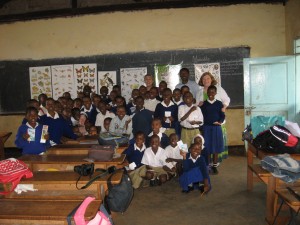Africa’s Colonial Legacy
The afternoon after we visited the schools we attended a lecture on Africa’s colonial legacy given by Dr. Martha Murayo of Mwenge University and College of Education. She and one of her students talked to us about what lasting effects, both positive and negative, that the imperial powers (Belgium, England, Portugal, Germany, and France) left with Africa after colonization was over.
They focused on two main theories surrounding this issue: Modernization Theory and Dependency Theory.
Modernization Theory explains that the imperial powers came to Africa to “modernize it†in a European way, or to “civilize†Africa. This begs the question “what does it mean to be civilized?†Our speaker summed it up, and I agree, as the ability to live among each other. The imperial powers failed to recognize that many tribes already had sophisticated norms and rules among their society, and did not need to be “civilizedâ€. Dependency Theory (also referred to as underdevelopment theory) refers to Europeans wanting to exploit African countries to develop their own countries.
Even though colonization began around 1920, understanding the legacy of colonialism is essential to understanding the culture, economy, and people of Africa today. Poverty across the continent is a major problem, and largely African economies have not been able to find their own power. Our speaker described it as a “set light†effect. The moon has a “set lightâ€. When we look at the moon it appears to glow, but really the moon receives all of it’s light from the sun. This is much like many companies that appear successful in Africa. Coca Cola has a thriving business in many countries in Africa and practically everywhere you look you will see advertisements for Coca Cola. However, where is the real producer of Coca Cola located? The U.S.A. of course! When will Africa produce it’s own light?
African raw products (such as tea) are sold to the United Kingdom and other countries where they are processed, packaged, and then sent back to Africa and sold for a much higher price.
Our speaker also described many of the continent’s economic problems stemming from Africa adopting western tastes, but without western skills. They have adopted western consumption patterns, without western industrialized techniques.
One of the things that I found most interesting, was when the speaker addressed colonialism’s effect on tribal war. I feel that many people in our world have heard little about Africa except hearing on the news the violence that happens between different tribes who are at war. Our speaker told us that tribes were really not tribes at all, but rather most would describe themselves as independent nations, so when the imperial powers showed up and created new boundaries, splitting some tribes lands in half, or forcing some tribes to move off of land they had lived on for generations…..well, one can see where serious complications arise. The imperial powers also imposed “divide and rule†where (to prevent uprisings) they purposely turned tribes against one another.
The lecture ended with several discussion questions which I still don’t have the answers to. How come other countries who were colonized (such as India) have been able to become industrialized while Africa has yet to “find their own light� Why is this information not taught in schools today? Where does the slave trade fit in to this discussion?
One thing that really stuck with me after the lecture was the way the presenters spoke about these issues. If my ancestors had faced such hardships I think I would be very bitter and hateful toward the people who had done these things to me. While our speakers recognized the harsh realities surrounding their past, they did not present the lecture from an angry perspective. They even pointed out some positive effects of colonialism such as public school systems and modern medicine. Would Africa be in a better place without colonialism? Probably. But we will never really know. What we do know is we must deal with our current reality, and one way to spread light on this issue is to educate people about colonialism. Sitting in on this lecture made me wish I had taken a graduate school course on colonialism. Fascinating! Feel free to post your own questions and ideas below!











